This recipe is a traditional, wild fermented sauerkraut with roasted garlic and black pepper incorporated. If you love garlic, crisp sauerkraut, and a light pepper flavor then this Roasted Garlic Sauerkraut with black pepper recipe is for you!
Ingredients for Roasted Garlic Sauerkraut with Black Pepper
- Cabbage: I suggest green cabbage for this recipe. A small head of cabbage will make about two jars of sauerkraut using this recipe. Look for a cabbage that still has outer leaves at the store. Usually, if a cabbage still has its outer leaves it’s more hydrated and fresh.
- Garlic: I used half of a garlic bulb for one jar. Below I’ll go over the steps to roast the garlic.
- Black Pepper: You can use fine ground pepper, medium ground pepper, or whole black peppercorns.
- Sea Salt: I like to use unrefined solar evaporated sea salt. Any pure sea salt will do. If you like to experiment with fancy sea salt in fermentation recipes, I suggest trying out French grey sea salt.
- Water: I add a bit of water to all of my cabbage fermentation recipes. Water is still drawn out of the cabbage when salt is added. However, having water as a part of this recipe accounts for seasonal changes in produce hydration levels. So no matter where you are in the world, or what your cabbage is like, you should have success with this recipe.

Dry Roasting Garlic
Do not, under any circumstances roast garlic with oil for this recipe.
Fermenting vegetables with oil can have negative consequences. I simply cut a whole garlic bulb in half, unpeeled. Then I put it face down on a parchment paper-lined pan, and roast at 400 degrees F for 35 minutes. After that, I allow it to cool. When you squeeze the cloves, they will slide right out. Some can be softer and mushier than others, and that’s fine.

Supplies You’ll Need to Ferment Sauerkraut
- 32 ounce Wide Mouth Mason Jar
- Fermentation Weight
- Standard Metal Mason Jar Lid (this can rust in the presence of salt)
- OR Rust Free Plastic Lid
- or you can use a Weck Jar (without the gasket; only use the clips to secure the lid)
- Sea Salt
- Scale
- Mixing Bowl

Roasted Garlic Sauerkraut Tips
During the first few days of fermentation: carbon dioxide and bubbles will be produced. Sometimes, jars will become very full of liquid, and this liquid can seep out.
- If using a standard mason jar lid: remove the lid and tamper everything back down using a gloved hand, tamper, or spoon. Make sure everything, including the weight, is still submerged below the brine.
Always Trust your sense of smell: Fermented cabbage should smell pleasantly sour and like strong cabbage. Never eat anything that smells repulsive or yeasty.
Never eat anything that had mold growing on it: By following directions you should not encounter this problem.
Taste test at three weeks: If you prefer the sauerkraut to be more tart and sour, you can let it ferment for four weeks.
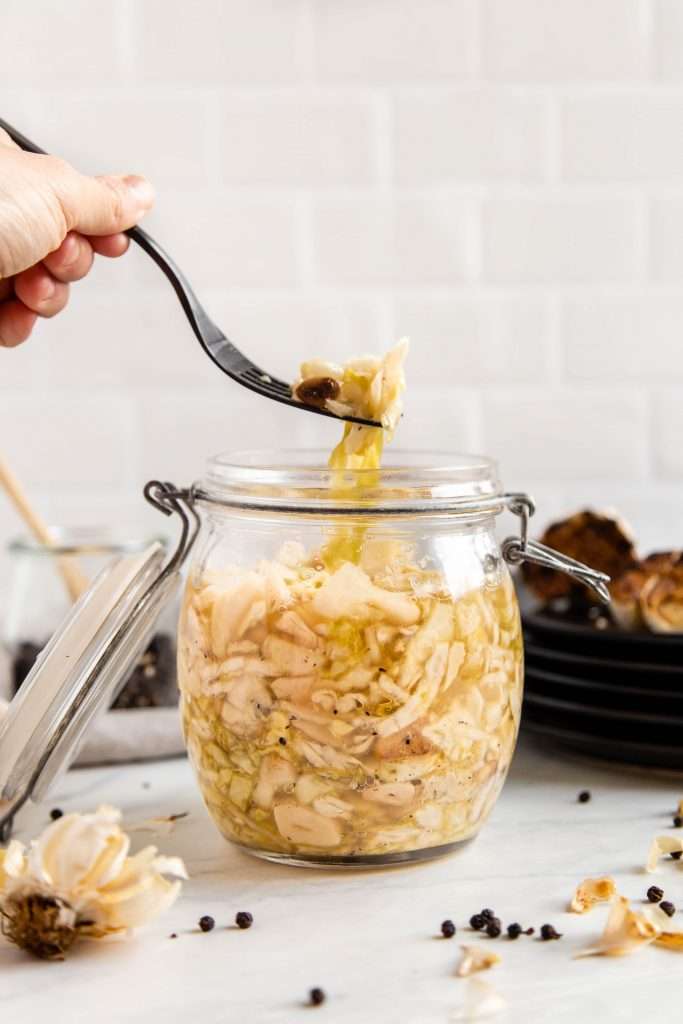
What Temperature Should I Keep My Fermented Roasted Garlic Sauerkraut At?
Keep your fermenting cabbage at a temperature between 70-80 degrees F. Keep out of direct sunlight
How Long Should I Ferment My Homemade Sauerkraut?
After 3 weeks, remove the fermentation weight and smell and taste test. Your fermented cabbage should smell pleasantly sour. It should taste tart, lightly salty, and cabbagey.
Do I Need to Refrigerate Sauerkraut?
After fermenting for 3 weeks, remove the weight and place a regular mason jar lid on the jar and refrigerate. Consume within 6 months for full probiotic benefits

Roasted Garlic Sauerkraut with Black Pepper Fermentation Timeline
We tracked our kraut throughout the fermentation process. By checking the progress of microbial stages under the microscope we have provided you with this handy timeline! If you follow our recipe and directions, your timeline of sauerkraut fermentation should approximately match ours.
24 – 48 hours: All contents in the jar should be submerged beneath the brine. At this time there are still Gram negative bacteria and possible pathogens present.
48 hours – 5 days: After 48 hours you should start to see lots of bubbles being produced. This is when the ferment enters stage two of vegetable fermentation. Leuconostoc bacteria begin to thrive and Gram negative organisms die off by day 5.
5 – 10 days: The bubbles in the brine will decrease, as the ferment leaves stage two and enters stage three. The ferment will become cloudy, the color will change and a pleasant sour smell will develop. Lactobacillus species begin to thrive in this time period.
10 – 21 days: Lactobacillus make up majority or all of the microbial population. They produce copious amounts of lactic acid and make the fermented cabbage smell even more pleasantly sour. This is the time in which the vegetable mixture becomes sauerkraut and is preserved.
More Sauerkraut Recipes to Try
- Turmeric Napa Cabbage Sauerkraut
- Homemade Kimchi Inspired Spicy Sauerkraut Recipe
- How to Make Old Fashioned Sauerkraut with Caraway Seeds
- The Benefits of Eating Sauerkraut Daily

Roasted Garlic Sauerkraut
This recipe is a traditional, wild fermented sauerkraut with roasted garlic and black pepper incorporated. If you love garlic, crunchy and tart sauerkraut, and a light pepper flavor then this Roasted Garlic Sauerkraut with black pepper recipe is for you!
- Prep: 15 Minutes
- Cook: 0 Minutes
- Total Time: 15 minutes
Ingredients
- 450 Grams Cabbage, Chopped
- 50 Grams Garlic, Roasted
- 1 Teaspoon Black Pepper
- 200 Grams Water
- 20 Grams Sea Salt
Instructions
- Wash your fermentation equipment (jar, weight, and lid)
- Remove the outer leaves of your cabbage and lightly rinse with cool water. Using a knife, chop the cabbage to your desired thickness.
- Place your kitchen scale on the counter. Turn it on and set it to weigh in grams.
- Place a mixing bowl on your kitchen scale and tare/zero the scale.*
- Add the designated amounts of chopped cabbage, roasted garlic* and black pepper into the bowl.
- Remove the bowl of cabbage from the scale and set aside. Place a small, empty bowl on your scale and tare/zero the scale. Weigh out the salt.
- Add the salt into the bowl with the cabbage, and mix with your clean hands until the cabbage becomes wet. This usually takes about 5 minutes.
- Place your empty, clean mason jar on the scale, and tare/zero the scale. Make sure your scale is still set to grams and add the water to your mason jar.
- Add the water into the bowl with the cabbage and salt. Mix everything well for about 2 minutes.
- Starting with the liquid, add the entire contents of the bowl into your mason jar, and pack everything down using a tamper, wooden spoon, or your hand.
- Place your glass fermentation weight in the jar, making sure to submerge the cabbage pieces and weight fully into the liquid. If you don’t have quite enough liquid, place your glass fermentation weight in the jar and submerge as much as possible. Over the next 12 hours, the cabbage should release more liquid and you can press down your fermentation weight below the brine.
- Secure the solid lid to the jar. You do not need to tighten it all the way. Just secure the lid but leave it ever so slightly loose, so the gas doesn’t build up too much.
- Ferment for 21-28 days, then remove the weight and refrigerate. Don’t forget to burp the jar daily during the bubbly phase, making sure everything stays submerged.
- If you try this recipe and love it, please leave a five-star review below!
Notes
This recipe at 1x works best with a quart-sized jar
*To Roast Garlic: simply cut a whole garlic bulb in half, unpeeled. Then put it face down on a parchment paper-lined pan, and roast at 400 degrees F for 30 minutes. After that, allow it to cool. When you squeeze the cloves, they will slide right out. Some can be softer and mushier than others, and that’s fine
*Taring/zeroing the scale with a container on it subtracts the weight of the container, allowing you to weigh only what is added to the container. After taring/zeroing the scale, it should read 0.0 with the container on it.
100 grams water = 100 mL water

















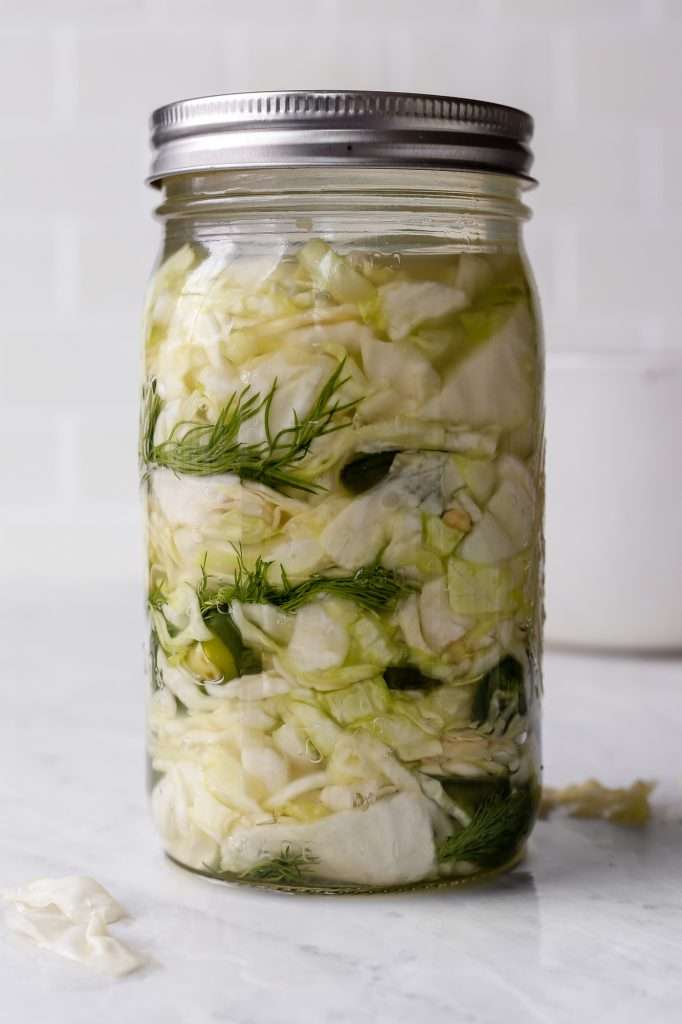


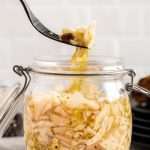
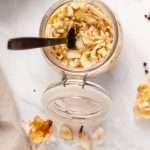

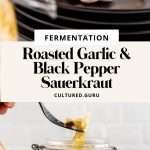
This is brilliant! I’m a huge fan of sauerkraut, but the last time I tried to make it they came out really mushy. I’m excited to try this recipe! Thank you for sharing!
This recipe is SO GOOD! Perfect balance! We add it to every meal, I wish I’ve done more of it!!!
I’m so glad that I stumbled upon your web-site. I’ve been wanting to try making sauerkraut but I never did because I was concerned about food safety. Your in-depth explanations on microorganisms have given me the courage to finally give this a try. I have a question about the Roasted Garlic Sauerkraut. Your recipe calls for 12 grams of sea salt. If my math is correct this works out to a 2.18% brine (12 grams divided by 550 grams total weight = 2.18%). I’ve read elsewhere on your web-site that a 2.5% brine is recommended for cabbages. Could you please explain why 2.18% is adequate and safe for this recipe.
I love your web-site!!!
Hey there,
Thanks for enjoying our blog. Yes, I suggest the addition of 2.5% salt by weight (a 2.44 % total salt concentration) for most at home fermenters when fermenting cabbage. This is a “fool proof” salt concentration that prevents any issues and cuts down on the time I have to spend troubleshooting with people.
It’s not a % brine. It’s a % total (w/w) salt concentration. So yes, if you include the roasted garlic in the calculation, your math is approximately correct. You’d have to include the weight of the peppercorns too to be exact.
The recipe is safe because I’ve validated it with microbiological testing, as with all my recipes. I chose to not include the 50 grams of roasted garlic (or the black pepper) in my salt concentration calculations for two reasons. 1. It doesn’t contain much water, so it doesn’t increase the water activity (a w) 2. It was dry roasted at 400 °F meaning it contains no microbial life, thus does not contribute to the microbial population.
So 500 grams of raw ingredients that contribute water activity to the recipe multiplied by 2.5% is 12.5 grams.
I chose to round down because after much feedback some people have informed me that the kitchen scales they bought don’t have a decimal place.
Kaitlynn,
Thank you for the quick, clear and detailed response!
I appreciate that you took the time to provide such a detailed explanation and this gives me full confidence in your work.
Can’t wait to try this recipe. I love the site and the detailed scientific explanations. Both nerdy and digestable!
Hi! About to try this. Can you please clarify: what size jar? Can I double the recipe? How much room should be left at the top?
Hi Amy,
Check the notes section of the recipe. This recipe at 1x works well with a quart-size jar. There are buttons at the top of the recipe card to double and triple the recipe. You should increase the jar size accordingly.
Hi – I’m on day 10 of this ferment and have noticed that my top vegetables are no longer submerged and there seems to be less water/brine. Is this normal? I have not opened the jar since day 1.
Hey there,
Please check the blog post above the recipe card that outlines care instructions throughout the duration of fermentation. You should remove the lid and press everything back down into the brine, clean the lid and place it back onto the jar.
Starting this recipe today 🙂 got extra cabbages this week. I’m not planning on roasting my garlic, as I quite like the sharpness of raw garlic in fermented foods. I hope it works out okay. I’ll edit this post with a review in a few weeks 🙂
Glad to hear you are trying the recipe! I think the raw garlic will be great 🙂
I usually refrain from buying commercially grown cabbage due to concerns about indiscriminate use of pesticides/insecticides here in the Philippines. Organically grown vegies are more expensive and not widely available. My question is, does any chemical residue affect the microbial population on the cabbage and would it change fermentation parameters? Thank you.
It all depends on the chemical being used. Some pesticides and fungicides can destroy vegetable and soil microbiomes, making wild fermentation of those vegetables difficult. However, cabbage is considered a “clean 15” vegetable even if grown conventionally. Since you remove the five or so outermost leaves before using the cabbage, there’s basically no pesticide residue… also, a few of the microbial species involved in wild fermentation have the ability to degrade pesticide residues.
Thank you for the reply. Great info. I’m now more inspired and confident to continue doing lacto fermentation with a science based approach.
Hi!
Thank you so much for your perfect recipe. The only thing that is not so perfect in my situation is that:
Cabbage even in the grocery can contain wax or pestide so I usually rinse it with baking soda to get rid of them( in many articles they said it is effective up to 90% of the time).
My question is, can baking soda also disrupt the fermentation of cabbage ( I hope not 🙁 )… ?
a bit of wax on cabbage leaves is natural, this is called epicuticular wax, and it is secreted by the cabbage leaves. Cabbage is a “clean 15” vegetable. Once you remove the outer leaves, cabbage is extremely clean with little to no pesticide residue. Also, the lactobacillus spp. involved in vegetable fermentation are great at degrading any residual pesticide residues.
Rinsing the cabbage with baking soda can disrupt the microbiome and cause insufficient fermentation.
Thanks for this recipe. I had tons of cabbage so made 4 jars of this. I just tried them about 4 weeks after making them, and 1 of the 4 jars tastes different than the others. It smells/tastes more sour. Is this variation normal or should I toss it?
could be just a slight variation in the cabbage if you used multiple cabbages to make it. Or maybe it was in a slightly warmer spot on the counter than the other jars. It’s normal, and if it’s more sour that means it’s more acidic so it’s safe to eat.
Thanks for confirming! I did eat some yesterday and didn’t experience any signs of food sickness. I’m glad I don’t have to toss it. Thanks for the recipe !
I am new to fermenting and I was thinking of getting some weck jars for this recipe. Can you burb the weck jars easily or do I need an air lock. Thanks
you do not need an airlock. You can use the regular weck jar glass lid with the clips to secure it, leave the gasket off, and set the jar in a dish to catch any seepage. This keeps everything submerged perfectly, without needing to burp the jar.
This came out amazing!! Can I quadruple the recipe or will multiplying the quantities not work? Thanks!
you can quadruple it!